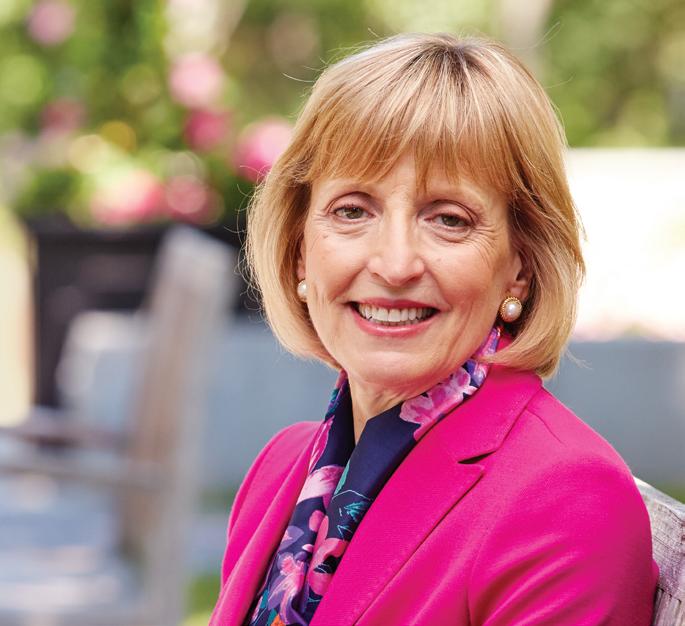
4 minute read
Five Things: What you should know
5
THINGS YOU SHOULD KNOW ABOUT THINGS THINGS YOU SHOULD KNOW ABOUT VAPING
Advertisement
BY MOLLY MASTANTUONO
Electronic cigarettes have sparked debate since their introduction in 2008. Concerns fared last summer as a mysterious lung ailment, now dubbed EVALI, hospitalized several thousand Americans and led to more than 50 deaths. A cross-section of faculty led a panel discussion to consider the legal, social and health implications of vaping. Here are highlights. Electronic cigarettes have sparked debate since their introduction in 2008. Concerns fared last summer as a mysterious lung ailment, now dubbed EVALI, hospitalized several thousand Americans and led to more than 50 deaths. A panel discussion, led by a cross-section of faculty members, considered the legal, social and health implications of vaping. Here are highlights.
E-CIGARETTES WERE BORN OF GOOD INTENTIONS. Many adult smokers have successfully used the devices to curb cigarette use. Dhaval Dave, Stanton Research Professor of Economics, cites recent fndings that vaping devices were twice as efective as nicotine patches, gum or prescription drugs at helping smokers quit. But, as he points out, adult smokers constitute a small portion of e-cigarette users. Most are teens and young adults, of whom 40% had never before used tobacco products.
THERE’S CONFUSION ABOUT INGREDIENTS. In one study, two-thirds of young users said that vaping liquids do not contain nicotine. In fact, virtually all do — along with other toxic ingredients. Zoe Wagner, lecturer in natural and applied sciences, notes that favoring agents, while approved by the Food and Drug Administration (FDA) for oral consumption, haven’t been tested to determine if they are safe to inhale.
USE BY HIGH SCHOOLERS IS RAMPANT. Te Centers for Disease Control and Prevention reports that 25% of high school students use vaping devices. Nearly half do so because of the appealing range of favors, such as cotton candy and bubble gum. Studies also show that teens and young adults are more likely to use traditional cigarettes and other tobacco products once they start vaping.
MAKERS ARE TARGETING YOUTH. Unlike traditional cigarettes, which are bound by strict advertising regulations, e-cigarettes are widely promoted through radio, TV and social media. Te latter category, which includes mobile ads and YouTube, is particularly efective in reaching a young audience. Associate Professor of Law Liz Brown warns that companies which expressly target younger consumers are engaged in negligent and even fraudulent marketing, since e-cigarette use is illegal for Americans under age 18.
REGULATION IS LARGELY LACKING. Most alarming, say Dave, Wagner and Brown: lack of industry oversight. Te FDA has regulatory authority via the Tobacco Control Act of 2016, but has yet to enact policies around e-cigarette manufacture, marketing or consumption. Absent federal regulations, state and municipal agencies have imposed their own, from restricting sales to outright bans. Te growing number of EVALI cases has kindled greater support for federal oversight, with proponents demanding the FDA take action.
Banking on Diversity
Alumni mentor a new generation for Wall Street

BY KRISTEN WALSH
Investment banks are changing the way they fnd young talent: Recruiting at an elite list of target colleges is giving way to an open process that will attract candidates who are more diverse. A new program at Bentley, developed by Abubakr Dumbuya ’07 (center), aims to prepare this new wave of applicants.
“Moving beyond the colleges where
investment banks have historically recruited eliminates initial bias for students at a non-target school,” says Dumbuya, an executive director at JPMorgan Chase & Co., whose focus is helping corporations use derivatives to manage interest rate and foreign exchange risk. “I want to take it a step further for Bentley students, by exposing them to alumni who can speak to the diferent roles in the feld and help them stand out in the application and interview process.”
Joining him in delivering the Wall Street Boot Camp are Derek Abdelmaseh ’09, MST ’12, associate, Technology M&A Investment Banking Group, Lazard; Nick DiGeronimo ’09, MSF ’10, vice president, Municipal Finance Department, Barclays; Christopher DiPietro ’08, vice president, Investment Banking Division, Canaccord Genuity; and Garrett Stephen ’09, director, Direct Lending Platform, THL Credit. Dumbuya worked through Bentley’s Pulsifer Career Development Center to implement the program.
INSIDE SCOOP Sessions run from November to April and include insights into the structure of an investment bank and various job functions, visits to Boston and New York City investment banks, and mentoring and guidance during the recruiting process.
“I’m drawn to the fast-paced and ever-changing work style, making huge deals and being around ambitious people,” says program participant Yuening (Nicole) Lyu ’22 (far left), a Computer Information Systems major. “I was surprised to see the diversity of majors, cultures and backgrounds in investment banking these days.” Finance major Cameron Tierney ’22 (near left) traces his interest in the feld to having a grandmother who liked to invest and watching entrepreneurs pitch to potential investors on TV’s Shark Tank. “I hope to gain industry knowledge from people who have the inside scoop,” says Tierney, a member of the student-run Bentley Sustainable Investment Group and the Investment Banking Club.
Both plan to use the experience to prepare for an internship — a critical frst step in landing a job in investment banking. Dumbuya, for example, completed summer internships at Bank of America, after his sophomore and junior years; he joined the bank’s Analyst program upon earning his BS in Economics-Finance. JPMorgan, which he joined in 2017, made headlines last year for changing its recruitment process. “Te shift benefts everyone,” he says. “In addition to opening up the pipeline for previously disadvantaged applicants, banks are leveraging a wider diversity of talent — in thought, race, gender, sexual orientation and mobility, for example — that benefts the company.”








